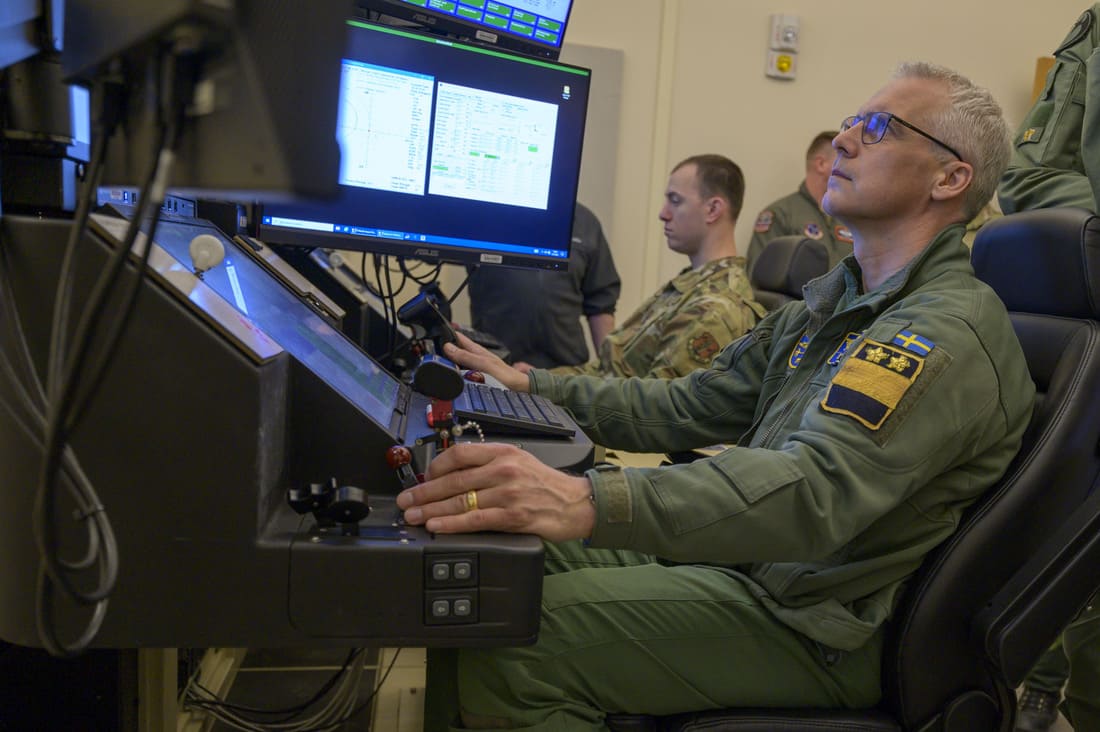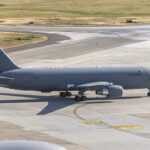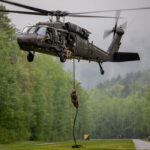The commander of the Swedish Air Force warned allied capitals that slow development cycles will cost them in a high-end war. “If we can’t develop at a faster pace, if we cannot innovate and learn under pressure like Ukraine does, we may lose,” Maj. Gen. Jonas Wikman told delegates in Rome on Nov. 4. He called the war in Ukraine a “masterclass in accelerated adaptation” and said “the side that learns fastest wins.”
Wikman pointed to field lessons from the front. “Tactics evolve weekly,” he said, noting that equipment supplied two years ago is used in different ways today. Ukraine has repurposed drones, munitions and sensors into new roles at a speed that exceeds normal Western acquisition cycles.
Swedish Air Force Builds Wartime Development Into GlobalEye
The remarks were delivered at the International Fighter Conference in Rome, held Nov. 4–6. Wikman pressed for shorter schedules and fewer bottlenecks so air forces can field updates during ongoing fighting.
The Swedish air chief described a “development cell” embedded inside the Swedish Air Force’s GlobalEye airborne early-warning unit, where officers, engineers, academics, and government researchers sit together under a single commander’s intent. The cell aims to push software updates, tactics, and integration work on a wartime clock, not a peacetime one. “Industry and academia must be integrated into our wartime organization, co-located, empowered and accountable under the commander’s intent,” he said.
Nordic commanders have asked industry for field-proven technology with minimal lag between prototypes and front-line units, according to industry sources. Air forces see a threat picture that shifted quickly since September, when Russian drones crossed into allied airspace and triggered additional NATO measures on the eastern flank.
NATO Activates Eastern Sentry Response to Russian Incursions
After multiple Russian drones violated Polish airspace on Sept. 9–10, NATO activated additional measures and launched Eastern Sentry on Sept. 12 to reinforce the eastern flank. Allied aircraft, air defence units, and surveillance assets are deployed under a flexible construct designed to adapt to evolving threats. Defence officials confirm these steps remain in effect, now part of a rolling deterrence posture.
Romania experienced similar intrusions during Russian strikes on Ukrainian infrastructure. Baltic and Nordic air forces have also logged multiple violations in recent months.
The European Commission in October unveiled a European Drone Defence Initiative, a plan for a layered counter-UAS network along the bloc’s eastern edge. The political goal is coherent coverage across national systems, with detection, tracking and neutralisation, and the capacity to expand quickly. Officials in Brussels target initial functionality in 2027.
NATO headquarters said in October that the risk window for a more direct Russian challenge in Europe stretches about five years. Statements called for stronger air and missile defences, higher munitions output, and resilience measures. Border incidents point to gaps in sensing and counter-drone effects that adversaries probe, according to allied officials.
Europe Moves Forward on Drone Defense Coverage
Sweden’s answer includes an airborne early-warning refresh. Stockholm ordered two GlobalEye aircraft in 2022 and added a third on June 27, 2024. The type will carry the Swedish designation S 106 and will replace ASC 890 platforms that Sweden pledged to Ukraine in 2024. Deliveries run through 2029, with initial capability earlier in the cycle. Public procurement records confirm the quantities, schedules, and S106 designation.
The GlobalEye unit is where Wikman’s development cell sits. The aircraft brings an extended-range Erieye ER radar and a modern mission system. The novelty is how Sweden plans to use it: frequent software drops, regular sensor-fusion tuning with operators in the loop, and direct tasking links to air defenders and naval assets. The arrangement puts technical staff beside squadron leadership instead of separating them by long acquisition gates.
The ASC 890 donation to Ukraine created an operational gap that forced acceleration. The Swedish government said in May 2024 it would transfer AEW&C aircraft to Kyiv as part of its largest support package. That decision pulled forward GlobalEye planning, training pipelines, and integration work at the Air Force and FMV.
Research partners have a formal role. Sweden’s Defence Research Agency (FOI) describes its mission as providing research-based support “from preliminary concept studies through materiel acquisition to real-time support during operations.” The mandate gives the air force a direct bridge to academia and applied labs when it needs fast analysis and test support for operational updates.
GlobalEye’s schedule fits within a wider Nordic surveillance debate. Manufacturers have promoted cooperative patrol concepts that link AEW platforms, ground radars, and fighters across the Arctic and Baltic approaches. Sweden is prioritising sovereign capacity paired with deep integration into NATO air policing now that Stockholm is a full member.
DIANA and Innovation Fund Accelerate Defense Technology Adoption
Allies set up two channels to accelerate the deployment of dual-use technology. The Defence Innovation Accelerator for the North Atlantic runs challenge-based sprints, connects companies to about 180 test centres, and funds selected teams with non-dilutive grants. This year’s cohort advanced 14–15 firms into Phase 2 with €300,000 each and access to NATO ranges. The network spans accelerators across Europe and North America.
Alongside DIANA sits the NATO Innovation Fund, a €1-billion venture vehicle backed by 24 allies. NIF announced initial direct investments in 2024 across edge computing, robotics, advanced composites, and on-orbit manufacturing, and continues to invest in early-stage funds that back defence-relevant technologies. The aim is to cut the time from lab to field by pairing capital with adoption routes through DIANA and national buyers.
Ukraine’s wartime adaptation shows where these pipelines point. Fibre-optic-tethered FPV drones overcame jamming in urban and trench combat. AI-assisted guidance improved terminal accuracy when links degraded. At sea, upgraded Sea Baby unmanned surface vessels extended range to roughly 1,500 km with heavier payloads, which forced the Russian Navy to shift basing and patrol patterns. Each step altered defender behaviour within weeks.
Investment patterns in Europe support the same trend. Private money flowing into defence and security technology rose sharply last year on demand for counter-UAS, robotics, secure communications, and advanced materials. According to industry sources, procurement offices now ask for modular hardware and software that accept quarterly updates and component swaps without full recertification.
Rapid Adaptation Becomes NATO Air Defense Strategy
NATO has begun to weave these ideas into daily operations. Under Eastern Sentry, AWACS flights and fighter patrols shifted across sectors, and ground-based air defences layered with national systems to close detection and engagement gaps exposed in September. Officials confirm that allied jets, frigates, and sensors are rotating on short notice to complicate an adversary’s planning.
Wikman’s integration concept for GlobalEye fits this posture. A co-located development cell can push a radar-mode tweak after a week of Baltic sorties rather than months after a formal trials campaign. Mission crews capture operator feedback in real time. FOI and industry engineers validate changes against recorded data before the next rotation. “Industry and academia must be integrated into our wartime organization, co-located, empowered and accountable under the commander’s intent,” he said earlier.
Traditional acceptance testing, block upgrades, and multi-year integration gates produce stable baselines, yet they struggle when an adversary iterates quickly.
Our analysis shows that allies who adopt software-first upgrades, modular payloads, and operator-in-the-loop testing within squadron life will close the adaptation gap faster than forces waiting for perfect configurations.
REFERENCE SOURCES
- https://english.alarabiya.net/News/world/2025/11/05/russia-s-suspected-hybrid-war-puts-european-defenses-to-the-test
- https://breakingdefense.com/2025/11/nato-must-innovate-like-ukraine-or-risk-losing-a-fight-with-russia-swedish-official/
- https://www.reuters.com/world/europe/ukraines-sea-baby-drones-are-growing-up-with-longer-range-bigger-payload-2025-10-22/
- https://www.defensenews.com/global/europe/2025/10/22/ukraine-unveils-upgraded-sea-drone-for-black-sea-strike-missions/
- https://www.aljazeera.com/news/2025/9/12/nato-announces-plan-to-strengthen-europes-eastern-flank
- https://www.theguardian.com/world/2025/sep/14/russian-drone-incursion-poland-nato-ukraine-europe
- https://www.aljazeera.com/news/2025/9/14/romania-reports-drone-incursion-during-russian-attack-on-ukraine
- https://commission.europa.eu/document/download/56143695-ed00-4a70-a1de-c97e0b05ff07_en
- https://www.euronews.com/my-europe/2025/09/26/eu-launches-drone-wall-to-detect-and-destroy
- https://www.saab.com/newsroom/press-releases/2024/saab-signs-contract-with-swedish-fmv-for-a-third-globaleye
- https://www.flightglobal.com/defence/sweden-signs-contract-to-acquire-third-saab-globaleye-surveillance-aircraft/158927.article
- https://www.diana.nato.int/connect/nato-diana-announces-15-innovators-to-move-forward-to-next-phase-of-acceleration.html
- https://www.csis.org/analysis/chapter-9-technological-evolution-battlefield
- https://www.theguardian.com/world/2025/apr/23/they-cannot-be-jammed-fibre-optic-drones-pose-new-threat-in-ukraine



